في عالمنا الرقمي اليوم، يعد الموقع الإلكتروني المصمم بذوق رفيع أمرًا ضروريًا. من المرجح أن يتحول العملاء المحتملون إلى عملاء محتملين إذا كان لديك موقع إلكتروني مصمم بشكل جميل مقارنةً بما إذا كان لديك منصة عادية.
لحسن الحظ، يتيح مشهد تصميم الويب الحالي لأي شخص إنشاء موقعه الإلكتروني. ويرجع ذلك إلى القائمة اللانهائية من مواقع الويب التي لا نهاية لها أدوات التصميم المتاحة. ومع ذلك، يأتي كل منها بمتطلبات مختلفة عندما يتعلق الأمر بمجموعات المهارات والدراية الفنية.
بالنظر إلى هذه الفرضية، قد يكون الأمر معقدًا بعض الشيء لتحديد أفضل أدوات تصميم الويب التي يمكنك استخدامها. في هذه المقالة، سنتحدث معك حول ما تحتاج إلى البحث عنه في أدوات تصميم الويب وأفضل أدوات تصميم الويب لعام 2024.
دعنا نتعمق في الأمر.
ما الذي يجب أن تبحث عنه في أدوات تصميم الويب؟
بالنظر إلى عدد أدوات تصميم الويب المتاحة في السوق، قد يكون من الصعب اختيار أي منها يناسب احتياجاتك. إذن ما الذي يجب أن تبحث عنه بالضبط للمساعدة في زيادة إنتاجيتك وفعالية وقتك إلى أقصى حد؟
قوالب
الأول هو توافر القوالب الجاهزة للاستخدام التي لا تتطلب امتلاك مهارات متقدمة في تصميم الويب. فأنت تريد أداة تحتوي على قوالب مناسبة لأن ذلك سيسهل عليك البدء ويعطيك فكرة عن الشكل الذي سيبدو عليه موقعك الإلكتروني في نهاية المطاف.
مركز القوالب النهائي مركز القوالب الخاص ب ClickUp مليء بالقوالب المفيدة ل فرق التصميم ومديري المشاريع، ولأي سبب آخر لزيادة إنتاجيتك.
التخصيص
هناك ميزة أخرى يجب أن تبحث عنها وهي التخصيص. تتيح لك هذه الميزة فريق التصميم لتعديل تصميم الويب وجعله فريدًا من نوعه وفقًا لاحتياجاتك. يضمن التخصيص ألا يبدو موقعك الإلكتروني مطابقاً لمنافسيك. مع ميزات التخصيص، من الأسهل العمل على التعرف على علامتك التجارية وهويتك البصرية.
التكاملات
علاوة على ذلك، تريد أداة مصمم ويب مع تكامل النظام. أنت تريد أداة متوافقة مع نظام إدارة المحتوى الحالي الخاص بك حيث يصبح من الأسهل بعد ذلك استيراد محتوى جديد دون المساس بأداء موقعك.
خيارات
بالإضافة إلى ذلك، ابحث عن أدوات تصميم الويب التي تقدم مجموعة من الخيارات للخطوط والرسومات. هذا لأن الطباعة هي أفضل رهان لك لإنشاء هوية مرئية لموقعك على الويب. مع وجود الكثير من الخيارات، يصبح من الأسهل نسبيًا بالنسبة لك التعبير عن أسلوبك وربما التميز.
واجهة
أخيراً، أنت تريد أداة تصميم ويب بواجهة بسيطة ولكن قوية. هذا الأخير يخلصك من الكثير من الصداع والثغرات مما يسمح لك بالتركيز فقط على تصميم الموقع الإلكتروني بدلاً من قضاء ساعات لا تحصى في معرفة كيفية عمل الأداة.
أفضل 10 أدوات لتصميم المواقع الإلكترونية لجعل عام 2024 عامك الأكثر إبداعاً
في الماضي، كان يتعين على مصممي الويب في الماضي أن يكتبوا يدوياً و إنشاء مواقعهم الإلكترونية باستخدام كود HTML وCSS وJavascript. لحسن الحظ، لم يعد هذا هو الحال. فمع أفضل أدوات تصميم المواقع الإلكترونية، يمكنك بسهولة إحياء أفكارك.
إليك ملخص لأشهر أدوات تصميم الويب الأكثر شيوعًا موارد التصميم والأدوات التي ستجدها مفيدة في المستقبل.
1. انقر فوق 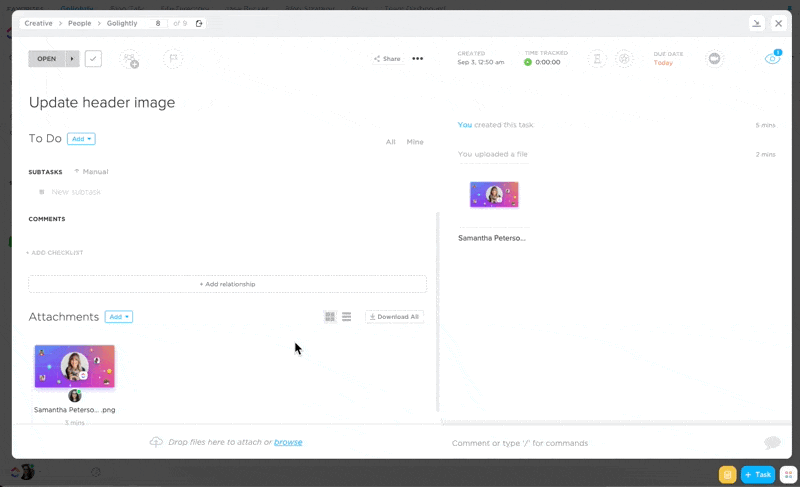
يمكنك وضع تعليقات توضيحية للصور بسهولة داخل ClickUp وترك أو تعيين تعليقات لفريق التصميم الخاص بك
إذا كنت تبحث عن أداة شاملة لإدارة التصميمات تعمل على تبسيط عملية التصميم، فيمكنك استخدام عملية التصميم ويساعد على مشاركة الملاحظات، ويزيد من موارد فريقك إلى أقصى حد، فإن ClickUp هي أداة مصمم الويب المناسبة لك.
باستخدام المنصة، يمكنك عرض جميع مشاريع التصميم الخاصة بك، وتتبع وتحسين كفاءة فريق التصميم الخاص بك، وتبسيط عملية التصميم ودمج جميع أدوات التصميم المفضلة لديك.
تستخدم ClickUp ميزات إدارة المشاريع القوية وتجمعها مع التعاون في المشروع أدوات لإبقاء فرق التصميم على نفس الصفحة.
الميزات:
- عرض كل شيء مما يتيح للمشاهدين رؤية كل شيء بغض النظر عن مكان تواجدهم في التسلسل الهرمي
- مساحة ومجلدات وقوائم يمكن من خلالها تنظيم فرق التصميم والأقسام
- مهام قابلة للتخصيص إلى جانب المهام الفرعية المتداخلة وقوائم المراجعة لسير عمل المشروع النهائي
- التحرير في الوقت الحقيقي للتعاون الفعال بين أعضاء الفريق
- تعليقات توضيحية لملفات PDF والصور الميزات
- أتمتة ClickUp لتوفير الوقت باستخدام وصفات أتمتة معدة مسبقًا تتضمن أكثر من 50 إجراءً ومحفزًا وشرطًا
- الخرائط الذهنية تساعدك على إنشاء مخططات مرئية جميلة من لوحة فارغة أو من خلال المهام الحالية
- مئات القوالب للفرق لاستخدامها
- تكامل سهل مع أكثر من 1,000 من أدواتك المفضلة
الايجابيات
- يدعم ClickUp أكثر منأكثر من 1,000 عملية تكامل
- تدريب مجاني
- دعم على مدار 24 ساعة
- تخصيص عالي المستوى
- يسمح لك وضع عدم الاتصال بالإنترنت بإنجاز العمل بدون اتصال بالإنترنت
- تطبيقات ClickUp للأجهزة المحمولة يتيح لك نقل عملك إلى أي مكان أثناء التنقل
سلبيات:
- قد يكون التخصيص العالي مربكاً للمستخدمين لأول مرة
التسعير:
- مجاني للأبد
- غير محدود: 7 دولارات شهريًا لكل مستخدم
- للشركات: 12 دولارًا شهريًا لكل مستخدم
- المؤسسات: اتصل لمعرفة الأسعار
التقييمات والمراجعات:
- G2: 4.7/5 (2,000+ تقييم)
- Capterra: 4.7/5 (2,000+ تقييم)
2. فيجما
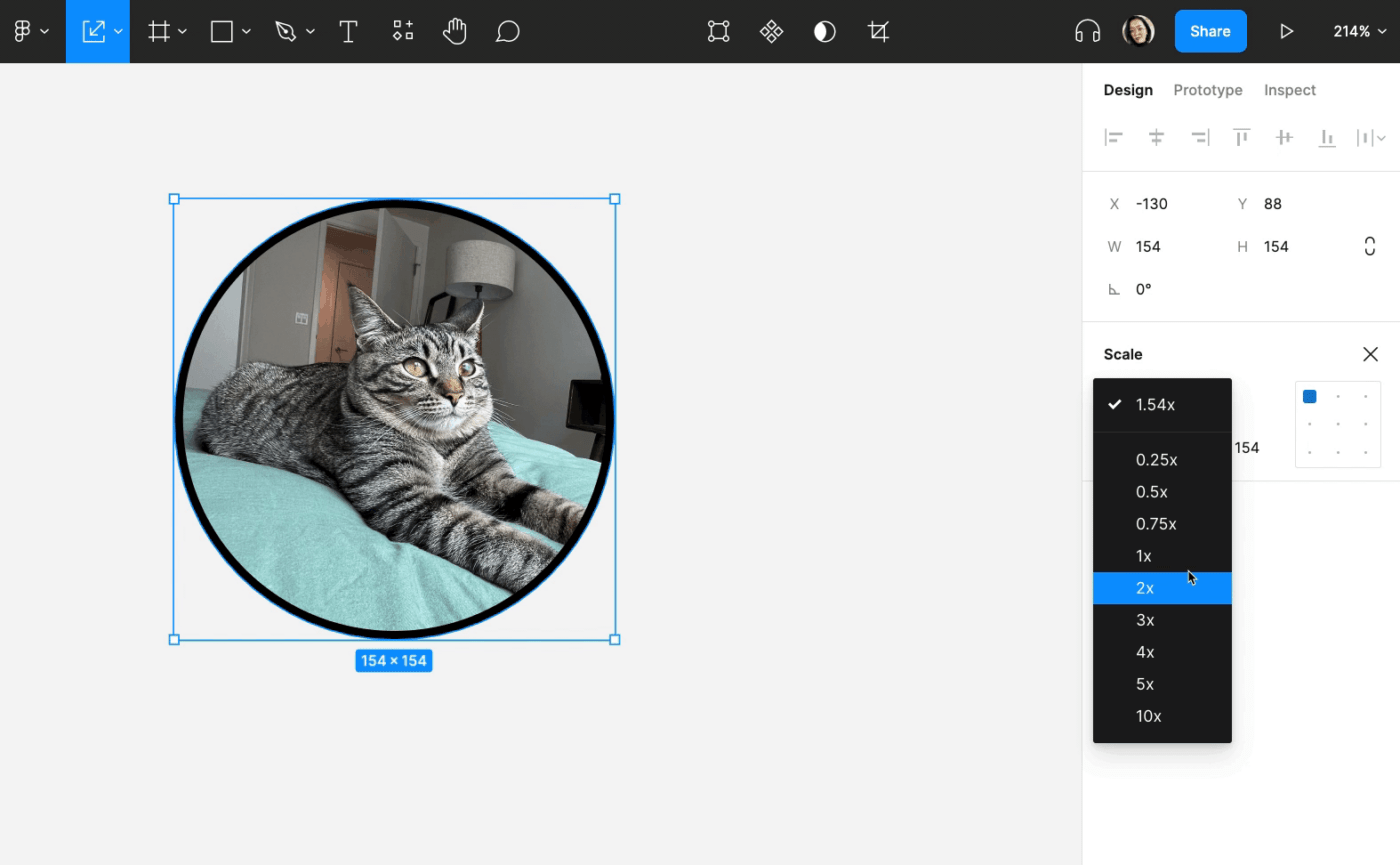
عبر فيجما فيجما هي منصة تصميم شاملة تربط الجميع في عملية التصميم بحيث يكون كل فرد في الفريق أكثر قدرة على تقديم المنتجات بشكل أسرع. برنامج تصميم الويب الخاص بها ممتاز للنماذج الأولية وأنظمة التصميم.
بمجرد التسجيل في فيجما، يمكنك الوصول إلى الأداة المرتبطة بالشركة FIGJAM. وتعمل هذه الأداة الأخيرة كأداة للسبورة البيضاء على الإنترنت حيث يمكن لفرق التصميم التعاون وتخطيط عمليات التصميم.
بعد فوات الأوان، يبدو أن فيجما صُممت لمستقبل الويب.
الميزات:
- واجهة برمجة التطبيقات
- الرسوم المتحركة
- أدوات التصميم بمساعدة الحاسوب
- أدوات التعاون
- التعليقات/الملاحظات
- استيراد/تصدير البيانات
- إدارة التصميم
- قوالب التصميم
- تسجيل دخول واحد
- تحرير الصور
- اختبار الأداء
- اختبار سهولة الاستخدام
المحترفين:
- قدرات لا حصر لها
- يمكن استخدام Figma لإنشاء نماذج أولية للتطبيق ونماذج بالحجم الطبيعي لفريق المنتج
- خفيف الوزن
- الكثير من الأدوات التي يمكنك استخدامها لتشغيل ورش عمل لا تنسى
- دعم بيئة تصميم تعاونية
السلبيات
- منحنى تعليمي حاد
- لا يوجد تطبيق للهاتف المحمول
التسعير:
- مجانًا لما يصل إلى 2 محررين و3 مشاريع
- احترافي: 12 دولارًا لكل محرر/شهر (فواتير سنوية) و15 دولارًا لكل محرر/شهر (فواتير شهرية)
- المؤسسة: 45 دولاراً لكل محرر/شهرياً (فواتير سنوية)
التقييمات والمراجعات:
- G2: 4.7/5 (729 مراجعة)
- Capterra: 4.7/5 (549 مراجعة)
3. كانفا
 أداة إنشاء مواقع الويب Canva
تقدم Canva لمصممي الويب مجموعة متنوعة لا مثيل لها من فئات الرسومات وآلاف القوالب المصممة باحترافية والتي من شأنها أن تجعل حتى الهاوي يبدأ العمل. وبفضل أداة إنشاء مواقع الويب Canva، من السهل جدًا إنشاء مواقع ويب من صفحة واحدة للأحداث والمحافظ ومواقع البيع بالتجزئة وغيرها.
أداة إنشاء مواقع الويب Canva
تقدم Canva لمصممي الويب مجموعة متنوعة لا مثيل لها من فئات الرسومات وآلاف القوالب المصممة باحترافية والتي من شأنها أن تجعل حتى الهاوي يبدأ العمل. وبفضل أداة إنشاء مواقع الويب Canva، من السهل جدًا إنشاء مواقع ويب من صفحة واحدة للأحداث والمحافظ ومواقع البيع بالتجزئة وغيرها.
وأفضل ما في الأمر أنه مجاني للاستخدام.
بالإضافة إلى ذلك، يتم استضافة المنصة على الإنترنت في السحابة ويمكن الوصول إليها من أي مكان باستخدام أي جهاز متصل بالإنترنت. ويمكنك استخدام Canva إما على متصفح الويب أو كتطبيق قابل للتنزيل على أجهزة Mac أو الكمبيوتر الشخصي أو Chromebook أو iOS أو Android.
إذا كنت تبحث عن أداة لتصميم الويب من أجل التحرير السريع للصور والفيديو، أو إنشاء موقع من صفحة واحدة، فإن Canva هي الأداة المناسبة لك. إذا كنت ترغب في مشاركة الجمهور على الموقع الذي أنشأته، فيمكنك أيضًا نشر Canva Insights الذي يوفر لك التحليلات الأساسية.
الميزات:
- مكتبة مدمجةقوالب للفرق
- تصميم متجاوب
- التعاون في الوقت الحقيقي
- قوالب الصفحة الواحدة لمواقع الويب المخصصة
- التحليلات مع Canva Pro
المحترفين:
- تنزيل المشروع المدمج سريع وموثوق
- يمكن للمستخدمين اختيار قالب بسهولة وبدء التحرير دون أي تأخير
- لا حاجة لخلفية تصميم
- موارد تعليمية ممتازة لأداة التصميم وأنظمة التصميم العامة
- مجموعة مثيرة للإعجاب من الأدوات الجديدة مثل أداة إنشاء مواقع الويب Canva
- واجهة بديهية تسهل الأمر على المصممين الهواة
- تجربة برنامج تصميم مواقع الويب سهلة الاستخدام
السلبيات
- يحتوي الإصدار المجاني على علامات مائية تمنع المستخدمين من تنزيل التصميمات أو تعديلها بشكل أكبر
- تنزيل ملفات متعددة يضغطها تلقائيًا في ملف مضغوط
- أخطاء من حين لآخر لأن Canva هو تطبيق ويب كامل
التسعير:
- مجاني
- كانفا برو: 12.99 دولارًا شهريًا أو 119.99 دولارًا سنويًا لمستخدم واحد
- كانفا للفريق: 14.99 دولارًا شهريًا أو 149.90 دولارًا سنويًا لأول خمسة مستخدمين
التقييمات والمراجعات:
- G2: 4.7/5 (3,771 تقييم)
- Capterra: 4.7/5 10,833 مراجعة)
_/مراجع/ /مدونة؟ ص=59846 تعرف على المزيد من بدائل Canva %/%href/_
!
4. ووردبريس
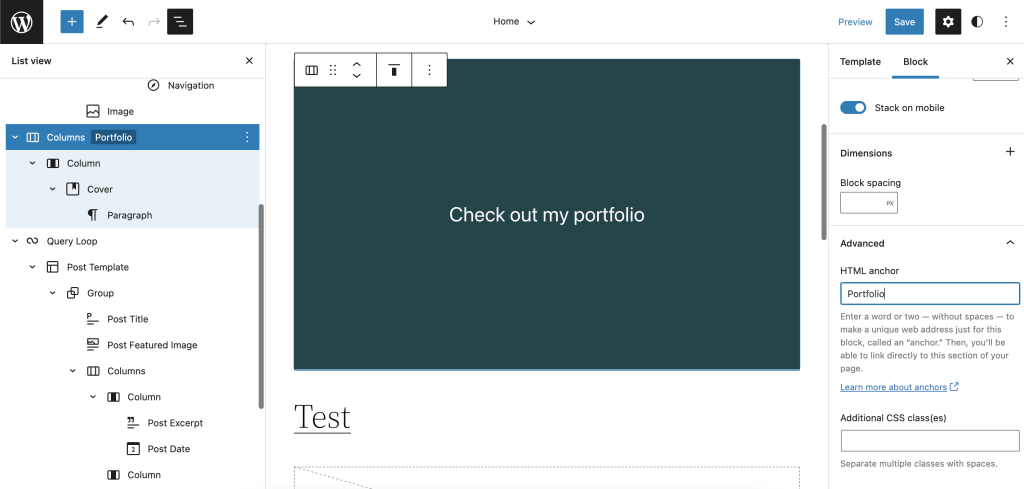
عبر WordPress.org اكتسب ووردبريس سمعة طيبة باعتباره الحل الأمثل لبرامج تصميم الويب من خلال تشغيل ما يقرب من نصف الإنترنت بالكامل. يتوفر للمستخدمين خيار إما WordPress.org أو WordPress.com وكلاهما يعتمد على نفس أدوات برنامج تصميم الويب الأساسية مع بعض الاختلافات الرئيسية فقط.
الأولى هي منصة ذاتية الاستضافة مما يعني أنك ستستضيف موقعك على الويب باستخدام خدمة مزود استضافة. من ناحية أخرى، يتم استضافة WordPress.com بواسطة Automattic.
بعد فوات الأوان، يبرز ووردبريس كأفضل منصة مجانية برنامج مدونة للمبتدئين
الميزات:
- الواقع المعزز
- تصميم مخصص
- بحث صوتي
- وضع إمكانية الوصول للأدوات
- أنواع المحتوى المخصص
- نشر الأخبار والمدونات المدمجة
- أمان موقع الويب المُدار
- دعم PHP 8
- الوضع المظلم
الايجابيات
- رخيص نسبيًا
- سهل الاستخدام للمبتدئين وسهل البدء
- مواقع الويب المصممة باستخدام ووردبريس تعمل بشكل جيد على أجهزة مختلفة
- نموذجي للغاية مع الآلاف من الإضافات والسمات
- يمكن للمستخدمين إنشاء أي نوع من مواقع الويب تقريبًا
- صُمم ووردبريس ليكون متجاوباً من خارج الصندوق مباشرةً
- ملائم لتحسين محركات البحث افتراضيًا
سلبيات:
- مشكلات تحديث برامج تصميم الويب
- ارتفاع تكلفة التخصيص
- ثغرات أمنية محتملة
- قد يكون تحسين سرعة الموقع أمرًا صعبًا
التسعير:
تختلف أسعار WordPress.org عن أسعار WordPress.com. WordPress.org مجاني. ومع ذلك، هناك تكاليف إضافية عليك تحملها بما في ذلك تكاليف شراء خطط استضافة مختلفة لأدوات التصميم الخاصة به.
يحتوي WordPress.com على خمس خطط تسعير.
- مجانية
- شخصي: 4 دولارات شهريًا، تُدفع سنويًا
- قسط: 8 دولارات شهريًا، تُدفع سنويًا
- شركة: 25 دولارًا أمريكيًا شهريًا، تُدفع سنويًا
التقييمات والمراجعات:
- G2: 4.4/5 (2387 تقييمًا)
- Capterra: 4.6/5 (1,414 تقييم)
5. أدوبي
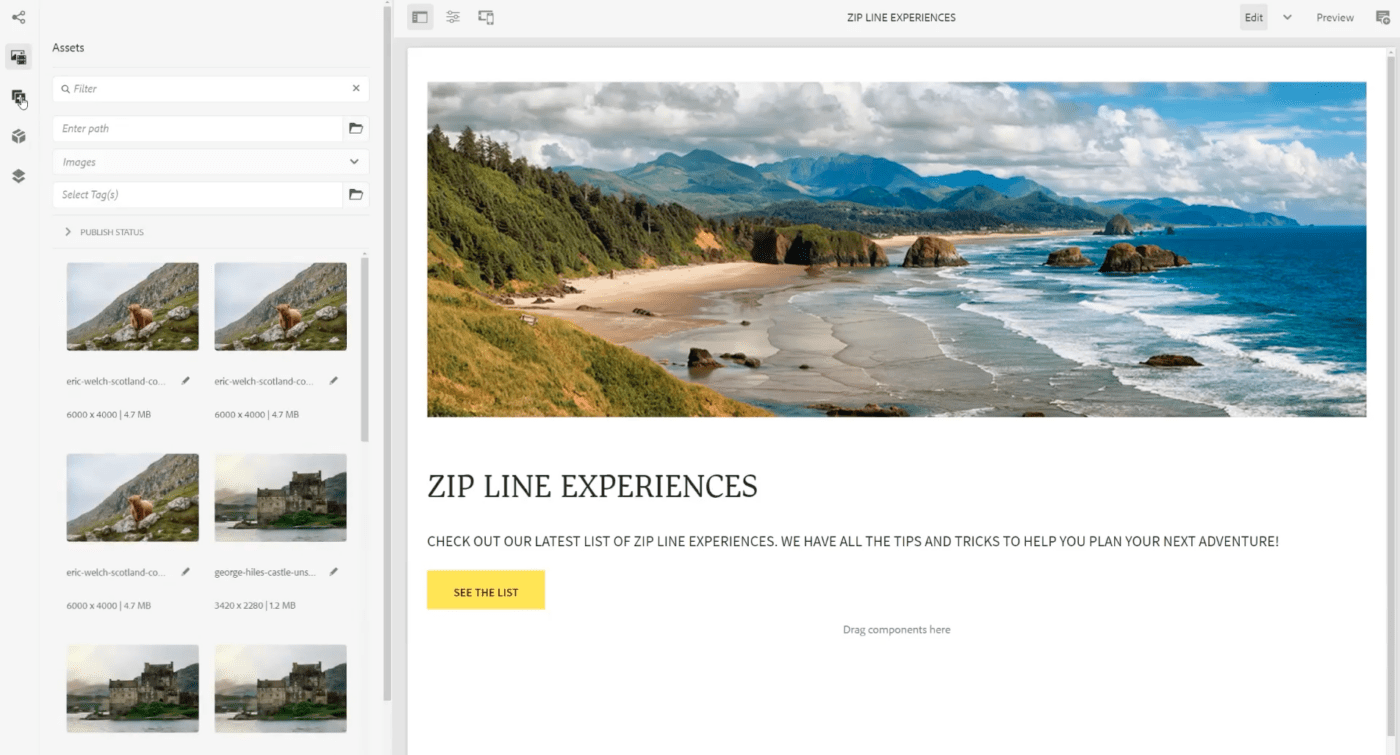
عبر أدوبي على الرغم من أنها جديدة نسبيًا في مجال برامج تصميم الويب، إلا أن Adobe أصبحت خيارًا طبيعيًا ل مصممي الجرافيك والويب . يتيح نموذج تصميم الويب هذا وأداة النماذج الأولية للمصممين وضع الأفكار والتعاون في مشاريع مختلفة.
مع وجود Adobe Photoshop و Adobe Illustrator في مجموعة أدوات برامج تصميم الويب، فإن شعبيته بين المصممين تترجم إلى العديد من البرامج التعليمية والموارد على الويب التي ستساعدك على البدء. هذا مفيد بشكل خاص عندما تبحث عن مساعدة Adobe Photoshop في أداة تصميم واجهة المستخدم.
تجعل أداة تطوير وتصميم الويب سريعة الاستجابة من السهل إنشاء مواقع ويب مخصصة جميلة لأي متصفح أو جهاز. تساعد أداة التصميم أيضًا أولئك الذين يرغبون في إنشاء تصميمات ويب سريعة الاستجابة.
الميزات:
- التعاون
- نظام تصميم الإطار السلكي
- نماذج تفاعلية تفاعلية لعملية تصميم الويب
- واجهة مستخدم معاد تصميمها وحديثة أكثر انسيابية وخالية من الفوضى
- الوصول إلى تلميحات التعليمات البرمجية
- دعم متعدد الشاشات لنظام ويندوز
- مساعدات بصرية لتقليل الأخطاء وتسريع تطوير الموقع
- دعم Git
المحترفين
- سمعة رائعة كبرنامج شاملأدوات تصميم تجربة المستخدم
- تكامل سلس مع الأدوات الأخرى
- أداء جيد حتى مع الملفات الكبيرة
سلبيات:
- لدى Adobe خيار تجريبي مجاني فقط لأدوات تطوير الويب الخاصة بها
- لا توجد إمكانيات تعاون في الوقت الحقيقي لتصميم الويب
التسعير:
- مجانًا: 1 مستخدم شهريًا
- تطبيق أدوبي دريمويفر الفردي: 20.99 دولارًا أمريكيًا في الشهر
- الشركات: 35.99 دولارًا شهريًا لكل ترخيص
- السحابة الإبداعية لجميع التطبيقات: 54.99 دولارًا أمريكيًا/شهريًا
التقييمات والمراجعات:
- G2: 4.6/5 (34,327 تقييم)
- Capterra: 4.8/5 (1,733 تقييم)
6. ويكس
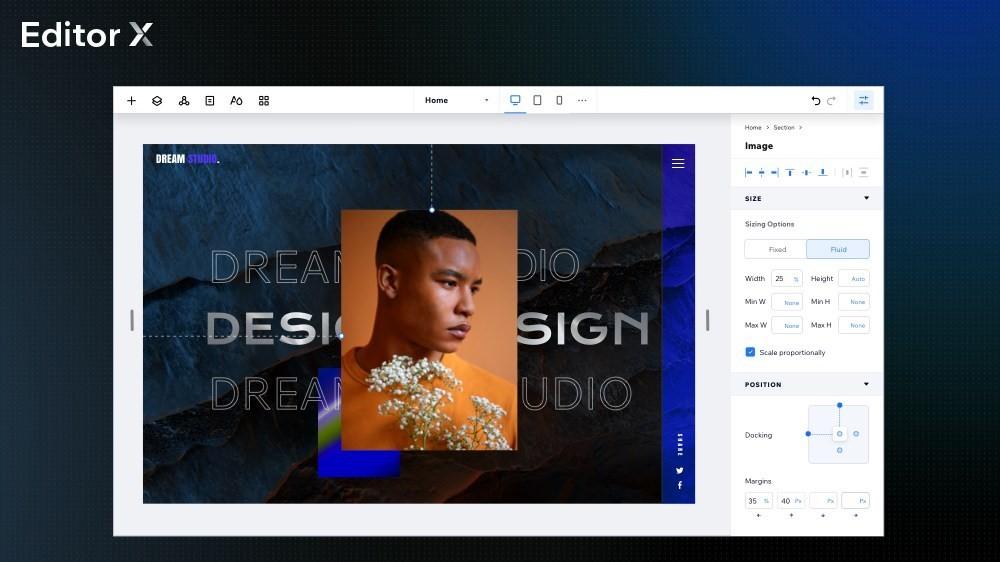
عبر تصميم محرر Wix Editor X Wix هي أداة مطور مواقع الويب التي تتيح لك تصميم وإدارة وتنمية وجودك على الإنترنت بناءً على احتياجاتك ومواصفاتك. بصفتك مطور ويب، لديك ثلاثة خيارات لبناء موقع الويب: Wix Editor و Wix Artificial Design Intelligence (ADI) و Velo من Wix.
مع Wix Editor، ستحصل مع Wix Editor على أداة إنشاء مواقع الويب سهلة الاستخدام مع إمكانية السحب والإفلات ومجموعة من القوالب القابلة للتخصيص التي تناسب تمامًا المبتدئين في تصميم المواقع الإلكترونية.
من ناحية أخرى، يعد ADI منشئ مواقع الويب المستقل الذي يساعد في تطوير موقع ويب كامل بعد أن يقدم المستخدمون تفضيلاتهم. لكن أداة إنشاء مواقع الويب هذه هي مفتاح WYSIWYG مع ميزات السحب والإفلات.
أخيرًا، مع Velo من Wix، يحصل المستخدمون على منصة مفتوحة المصدر يمكنهم من خلالها إنشاء تطبيقات متطورة لتطوير الويب. تعد هذه المنصة مثالية لمطوري الويب المستقلين الذين يتطلعون إلى إنشاء تجربة مستخدم موقع ويب مخصص.
إذا كنت بحاجة إلى أداة بديهية لإنشاء مواقع الويب وأداة سهلة الاستخدام مع مجموعة من خطط التسعير المعقولة، فإن Wix هي المنصة المناسبة لك. لديك الاختيار من بين أكثر من 500 قالب قابل للتخصيص مصمم مسبقاً.
الميزات:
- مدفوعات متكاملة عبر الإنترنت
- مبيعات متعددة القنوات مثالية للتجارة الإلكترونية
- بنية تحتية وأدوات ملائمة لتحسين محركات البحث لإنشاء مواقع الويب بسهولة
- أدوات مدمجة لإمكانية الوصول
- أدوات النطاقات المجانية
- تحليلات وتقارير مع أداة التصميم
الايجابيات
- Wix سهل الاستخدام ولا يتطلب أي جهد في تطوير الويب أو تاريخ في الترميز
- خطة تسعير ميسورة التكلفة مع برنامج أدوات مجانية
- تتمتع مواقع Wix بأسرع أوقات التحميل في النظام البيئي مما يجعل أداة التصميم هذه الخيار الأفضل لإنشاء مواقع ويب سريعة الاستجابة
- يوفر معالج تحسين محركات البحث (SEO Wix's Wix's SEO Wizard) نصائح مفيدة لتحسين موقعك الإلكتروني
- محرر السحب والإفلات البسيط لمصممي الويب الهواة أو المتمرسين
السلبيات
- إمكانية التخصيص المحدودة متاحة حيث لا يمكن للمستخدمين الوصول إلى كود الموقع الإلكتروني
- وظائف محدودة مما يجعل Wix غير مواتية للمستخدمين الذين يديرون مدونة أو متجرًا عبر الإنترنت
- لا يمكن للمستخدمين تبديل السمات دون فقدان المحتوى الخاص بهم أولاً
التسعير:
- كومبو: 18 دولارًا شهريًا
- غير محدود: 23 دولارًا في الشهر
- محترف: 28 دولارًا في الشهر
- VIP: 47 دولارًا شهريًا
يقدم Wix أيضًا بعض خطط الأعمال والتجارة الإلكترونية. وتشمل هذه الخطط:
- أساسيات الأعمال: 28 دولارًا شهريًا
- الأعمال غير المحدودة: 33 دولارًا شهريًا
- الأعمال VIP: 56 دولارًا شهريًا
- المؤسسات: 500 دولار شهريًا
التقييمات والمراجعات:
- G2: 4.4/5 (9.159 تقييم)
- Capterra: 4.4/5 (1.545 تقييم)
تحقق من هذه
/مراجع/ /مدونة؟p=125984 بدائل Wix //%href/
!
7. أعجوبة
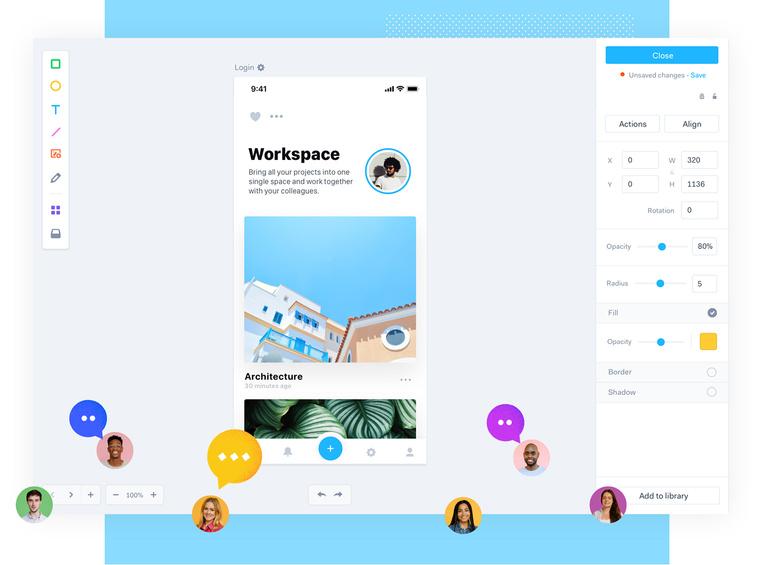
عبر مارفيل إذا كنت تبحث عن أدوات برمجية لتصميم الويب تقدم نماذج أولية سريعة واختبارها وتسليمها إلى السوق، فإن Marvel هي الأداة المناسبة لك. من بين أدوات إنشاء مواقع الويب في القائمة، تأتي هذه الأداة بوظيفة تصميم ونماذج أولية بديهية تجعل وضع الأطر السلكية والتصميم والنماذج الأولية سريعًا نسبيًا.
يمكن لفرق التصميم إنشاء مواصفات التصميم على الفور وربط عمليات التكامل التي تعمل على تشغيل سير عمل التصميم .
مع عدم وجود منحنى تعليمي وعدم وجود متطلبات لبرامج تصميم الويب، يعد Marvel خيارًا ممتازًا للهواة الذين يبدأون. يتوفر للمستخدمين، تحت تصرفهم مكتبة يمكن الوصول إليها من القوالب والأصول التي تزيل التعقيد من عملية التصميم.
يجعل Marvel من الأسهل بكثير تحويل نموذج التصميم إلى نماذج أولية تفاعلية عبر الإنترنت دون كتابة سطر واحد من التعليمات البرمجية.
الميزات:
- قوالب قابلة للتخصيص وسهلة الاستخدام عبر أداة التصميم
- قوالب العلامات التجارية القابلة للتخصيص لعناصر الويب المختلفة
- أيقونات مميزة محددة مسبقًا يمكن استخدامها في تصميم الويب الخاص بك
- يمكن تضمين الخطوط المتكاملة داخل الصور
الايجابيات:
- سير العمل بين لقطات الشاشة
- واجهة مستخدم نظيفة وبسيطة مع عناصر الويب ذات التخطيط التلقائي
- يمكن للمستخدمين إرسال رابط للمشروع إلى العملاء لسهولة الوصول إلى النماذج الأولية
- معظم الميزات مجانية مما يجعلها مفيدة بشكل خاص للمصممين الجدد والطلاب والمؤسسات غير الربحية
- قائم على الويب بحيث يمكن للمستخدمين الوصول إلى التطبيق من أي مكان متصل بالإنترنت
سلبيات:
- تحديات إنشاء مجموعات داخل النموذج الأولي
- الرسوم المتحركة على Marvel ليست سلسة أو سلسة كما في المنصات الأخرى
- لا يحتوي برنامج تصميم الويب على خيارات غير متصلة بالإنترنت
- لا توجد خيارات للتعليقات التوضيحية
- وظائف رسوم متحركة محدودة لتصميم الويب
التسعير:
تقدم أداة تطوير الويب 5 خيارات مع فرصة لبدء نسخة تجريبية مجانية أيضًا.
- مجاني (مستخدم واحد، 2 مشروع نشط): 0 دولار
- محترف (مستخدم واحد، مشاريع غير محدودة): 12 دولارًا شهريًا
- فريق (3 مستخدمين، مشاريع غير محدودة): 42 دولارًا شهريًا
- شركة (6 مستخدمين، مشاريع غير محدودة): 84 دولارًا شهريًا
- المؤسسة (عدد غير محدود من المستخدمين + المشاريع): اتصل للحصول على عرض أسعار
التقييمات والمراجعات:
- G2: 4.5/5 (1,168 تقييم)
- Capterra: 4.6/5 (83 تقييم)
8. تريلو

عبر تريلو إذا كنت تبحث عن أداة تعاونية لأداة تصميم الويب الخاصة بك، فإن تريلو هي الأداة المناسبة لك. تجعل هذه المنصة من السهل نسبيًا صياغة رسائل البريد الإلكتروني وجداول البيانات وجمع الفريق بأكمله مع وظائف السحب والإفلات لنقل المهام.
هذا على غرار كانبان برنامج إدارة المشاريع يسمح لقادة فريق التصميم بتتبع أداء كل عضو من أعضاء فريق التصميم. تساعدك أداة التعاون الرقمي في الحفاظ على الإنتاجية وتعزيز التعاون حتى في بيئة العمل الموزعة.
يمكن استخدامه لأغراض تصميم الويب، لكن Trello يعمل بشكل أفضل كحل لإدارة المهام.
الميزات:
- أغلفة البطاقات التي تجعل التعاون ملونًا
- مجموعة من اختصارات لوحة المفاتيح التي يمكن أن تكون منقذة للإنتاجية
- قوائم مراجعة متقدمة تسمح برسم خريطة واضحة لجميع الأجزاء المتحركة
- تشغيل التقويم لرؤية جميع عناصر قائمة المراجعة المعينة
- أتمتة الخادم للمساعدة في بناء سير عمل أفضل
- الوضع المظلم في تطبيق Trello لنظامي التشغيل iOS وAndroid
الإيجابيات:
- واجهة بديهية
- تحتوي الخطة المجانية على الكثير من الإمكانيات
- محرر السحب والإفلات ببطاقاته
- يمكن للمستخدمين الوصول إلى كل من الهاتف المحمول والكمبيوتر
- يمكن للمستخدمين إنشاء لوحات بسهولةمع أفكار للتفكير التصميمي
- يمكن إنشاء لوحات سويمولان متعددة لخدمة أغراض التذاكر المتعددة
سلبيات:
- تتطلب العديد من الميزات إضافات
- هناك حد أقصى لحجم الملفات القابلة للإرفاق والتي قد تكون محدودة في معظم الحالات
- التكامل مع MS Teams و Google Chat يمكن أن يكون أفضل
- ليس برنامج تصميم الويب النموذجي الخاص بك ولكنه حل لإدارة المهام
التسعير:
لدى Trello أربعة هياكل تسعير مع خيار تجريبي مجاني على خططه المدفوعة.
- مجاني
- قياسي: 5 دولارات لكل مستخدم شهريًا
- القسط: 10 دولارات لكل مستخدم شهريًا
- المؤسسة: 17.50 دولارًا أمريكيًا لكل مستخدم شهريًا بدءًا من 250 مستخدمًا يتم دفع فواتيرهم سنويًا
التقييمات والمراجعات:
- G2: 4.4/5 (12,993 تقييمًا)
- Capterra: 4.5/5 (22,289 تقييم)
تحقق من هذه
_/مرجع/ مدونة؟ p=7130* بدائل تريللو *%/%href/_
!
9. ويب فلو
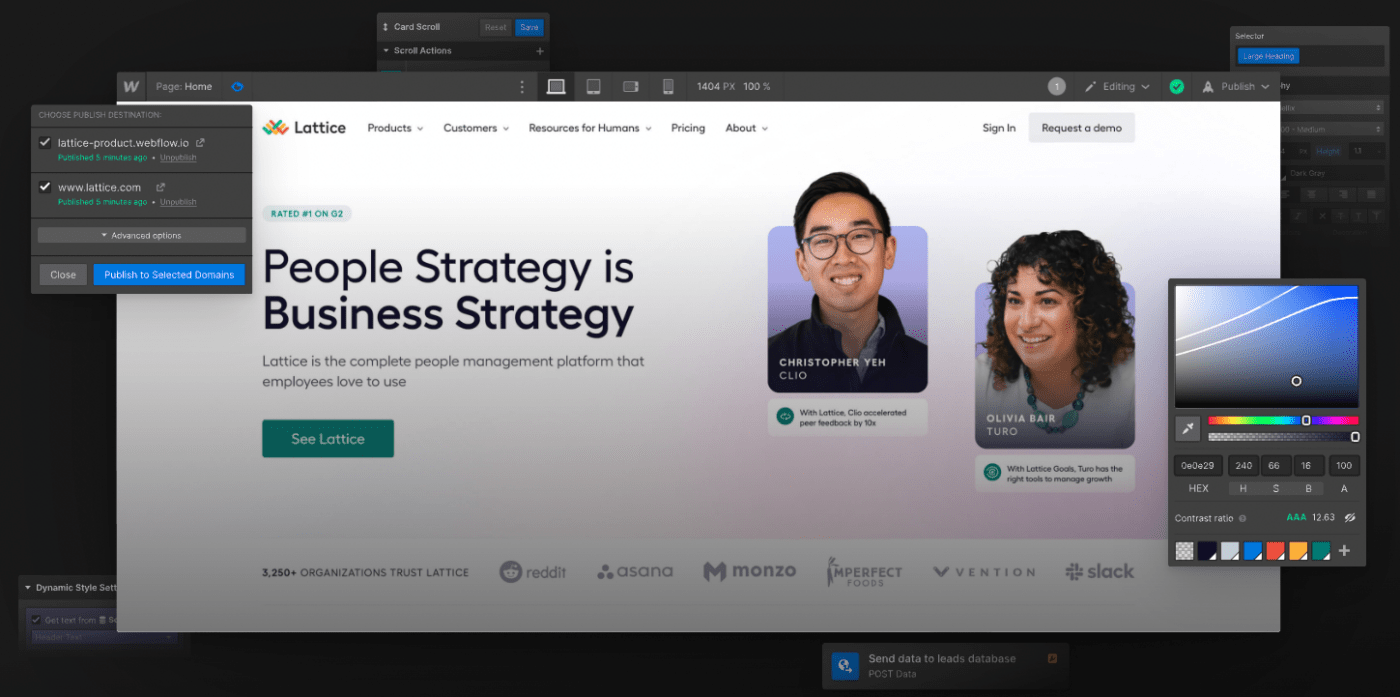
عبر ويب فلو Webflow عبارة عن منصة جديدة وشائعة لبناء المواقع الإلكترونية تتميز بمنصة محرر مرئي عبر الإنترنت يمكنك من خلالها تصميم مواقع الويب وإنشائها وإطلاقها. تسمح لك اللوحة المرئية بالتحكم في CSS3 وHTML5 وجافا سكريبت وترجمة التعليمات البرمجية الدلالية إلى مواقع مخصصة لعملية تصميم مواقع الويب في نهاية المطاف.
كما تتيح لك أيضاً استخدام عناصر HTML غير المصممة للتحكم في التصميم. وعلاوة على ذلك، يمكن للمستخدمين الاستفادة من القطع المبنية مسبقاً لتصميم عناصر معقدة بما في ذلك مقاطع الفيديو والعناصر الخلفية، وغيرها.
الميزات:
- الرسوم المتحركة القائمة على التمرير
- رسوم متحركة متعددة الخطوات
- ضوابط تحسين محركات البحث
- لوحة معلومات النشاط
- إدارة التقويم
- إدارة الحملة
- التحديث التلقائي
- تتبع النشاط
المحترفين
- يمكن لمصممي الويب ربط الحركة والرسوم المتحركة بموضع المؤشر لجذب انتباه المستخدم
- التعاون بسيط نسبيًا حيث يمكن دعوة العديد من المصممين للعمل على نفس الموقع الإلكتروني في نفس الوقت
- يمكن جعل مواقع الويب أكثر تفاعلية من خلال الاستفادة من لوحات العرض، والنماذج، والعناصر المخفية الأخرى
- يتوفر أكثر من 20 من الرسوم المتحركة والتفاعلات مسبقة الإنشاء مما يجعل إضافة الميزات فورية
سلبيات:
- لا يمكن ضغط الصور إلا يدوياً مما قد يستغرق وقتاً طويلاً
- لا يزال حد نظام إدارة المحتوى منخفضًا جدًا في بعض الخطط
- منحنى تعليمي حاد لمنشئ مواقع الويب
التسعير:
- الأساسي: 12 دولارًا شهريًا
- CMS: 16 دولارًا شهريًا
- الأعمال: 36 دولارًا شهريًا
- المؤسسات: خطة قائمة على التسعير
التقييمات والمراجعات:
- G2: 4.4/5 (401 تقييم)
- Capterra: 4.6/4 (193 تقييم)
10. ديزاينمودو
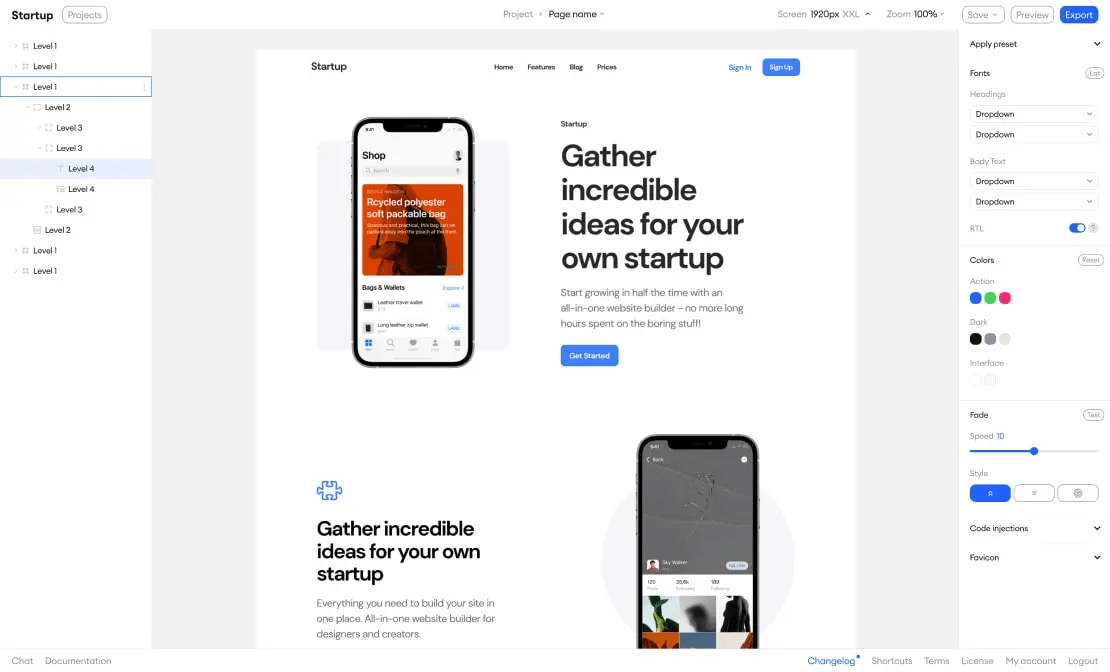
عبر ديزاينمودو Designmodo هو حل برمجي شامل لتصميم الويب حيث يمكن للمستخدمين إنشاء مواقع ويب ورسائل إخبارية. تعمل هذه الأداة بشكل أفضل للمستخدمين الذين يبحثون عن أداة للمساعدة في إنشاء صفحات ويب ثابتة أو مواقع ويب بالسحب والإفلات أو قوالب بريد إلكتروني.
يقدم Designmodo لمصممي الويب اثنين من أدوات إنشاء مواقع الويب: الشرائح وبدء التشغيل. باستخدام هذين الاثنين، يمكن للمصممين إنشاء موقعين إلكترونيين مخصصين وتشغيلهما عبر مضيف. يستخدم برنامج تصميم المواقع هذا خاصية السحب والإفلات، وهي بسيطة جداً وقابلة للتخصيص أيضاً. أداة التصميم تجعل العملية بأكملها خالية من المتاعب نسبياً.
الميزات:
- 100 مكون وحدة نمطية للعملاء المدفوعين
- تصميم متوافق مع الهاتف المحمول
- لوحة الوظائف
- قوالب النشرة الإخبارية
المحترفين
- وثائق Designmodo مفصلة بشكل جيد
- السحب والإفلات لوحدات المحتوى مصممة بشكل جيد
- واجهة نظيفة وسريعة عبر أداة التصميم
- تسلسل هرمي بسيط للمشروع
- لا يوجد منحنى تعليمي لمصممي الويب
سلبيات:
- خيارات قوالب محدودة لمصممي الويب
- لا يقدم Designmodo أي نسخة تجريبية مجانية
- يجب أن يتجاوز تخصيص الوحدات النمطية العمق المتاح
التسعير:
- خطة الأعمال: 18 دولارًا شهريًا
- خطة الوكالات: 29 دولارًا شهريًا
التقييمات والمراجعات:
- G2: 4.2/5 (18 تقييم)
- Capterra: 3.4/5 (10 تقييمات)
إدارة مشاريع تصميم مواقع الويب الخاصة بك كلها في مكان واحد
التعاون هو المفتاح لفرق تصميم الويب، مما يعني وجود العديد من الأشخاص الذين يعملون على مهام متشابهة في نفس الوقت. قم بتنظيم مشروعك باستخدام مجموعة ClickUp من أدوات إدارة المشاريع والإنتاجية وتصميم الويب الخاصة بـ ClickUp لتجنب الاختناقات وزيادة الكفاءة.
هل تريد أن ترى كيف سيعمل فريق تصميم الويب الخاص بك في ClickUp؟ قم بدعوة أعضاء فريقك و ابدأ مجاناً !

